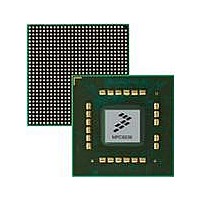MPC8536DS Freescale Semiconductor, MPC8536DS Datasheet - Page 882

MPC8536DS
Manufacturer Part Number
MPC8536DS
Description
BOARD DEV SYSTEM MPC8536E
Manufacturer
Freescale Semiconductor
Series
PowerQUICC III™r
Type
MPUr
Datasheets
1.MPC8536EBVTAVLA.pdf
(127 pages)
2.MPC8536EBVTAVLA.pdf
(1706 pages)
3.MPC8536DS.pdf
(2 pages)
4.MPC8536DS.pdf
(126 pages)
Specifications of MPC8536DS
Contents
Board, Software and Documentation
Processor Series
MPC85xx
Core
e500
Data Bus Width
32 bit
Maximum Clock Frequency
667 MHz
Operating Supply Voltage
- 0.3 V to + 1.21 V
Maximum Operating Temperature
+ 105 C
Data Ram Size
32 KB
Interface Type
SPI, USB
Program Memory Type
DDR2, DDR3, SDRAM
Core Size
32 Bit
Program Memory Size
544KB
Cpu Speed
1.5GHz
Digital Ic Case Style
BGA
No. Of Pins
783
Supply Voltage Range
0.95V To 1.05V
Rohs Compliant
Yes
For Use With/related Products
MPC8536
Lead Free Status / RoHS Status
Lead free / RoHS Compliant
- MPC8536EBVTAVLA PDF datasheet
- MPC8536EBVTAVLA PDF datasheet #2
- MPC8536DS PDF datasheet #3
- MPC8536DS PDF datasheet #4
- Current page: 882 of 1706
- Download datasheet (15Mb)
Enhanced Three-Speed Ethernet Controllers
14.5.4.1
The eTSEC’s TBI implements the transmit portion of the physical coding sublayer as found in Clause 36
of IEEE 802.3z. In SerDes mode, packets conveyed across the GMII are encapsulated and encoded into
10-bit symbols and output to the SerDes. In GMII mode, the GMII signals are passed through to the
attached GMII PHY.
14.5.4.1.1
If TX_EN is de-asserted the eTSEC outputs an idle stream. If TX_EN is asserted, a Start_of_Packet
symbol is output. This symbol replaces the first byte of the preamble field. All other bytes of the packet
pass through an 8B10B encoding module. After the last byte of the FCS field is signaled through the GMII,
the MAC de-asserts TX_EN. The eTSEC then outputs an End_of_Packet symbol. Then, depending on the
position of the End_of_Packet symbols (being in either an odd or even position) the eTSEC outputs one
or two Carrier_Extend symbols. Following the last Carrier_Extend symbol, the eTSEC resumes sending
idle codes. If, during a packet, the eTSEC wishes to mark a byte invalid, TX_ER is asserted. The eTSEC,
upon detection of TX_ER, substitutes the data symbol for an Error_Propagation symbol.
14.5.4.1.2
Every eight-bit data octet has two (not necessarily different) ten-bit symbols associated with it. Depending
on the running disparity (the cumulative difference of ones and zeroes) the eTSEC module chooses the
appropriate symbol.
Special encapsulation symbols are called ordered_sets. Ordered_sets are comprised of one to four ten-bit
symbols. Ordered_sets can be found in Clause 36 of the IEEE 802.3z specification.
14.5.4.1.3
Because the idle ordered_set comprises two symbols and begins on an even symbols boundary, packets
can only begin on an even boundary. However, the GMII has no such restriction and may signal TX_EN
on an odd boundary. If this happens, the eTSEC delays the Start_of_Packet symbol, effectively ignoring
the first byte of preamble; thus, a seven octet preamble becomes six octets on the Ten-Bit Interface.
14.5.4.2
The eTSEC’s TBI Implements the receive portion of the physical coding sublayer as found in Clause 36
of IEEE 802.3z. The Receive portion includes the Synchronization state machine. In SerDes mode, the
eTSEC first attempts to acquire synchronization on the link by examining received symbols. Once
synchronization is acquired, received packets are decoded and sent across the Receive GMII interface. In
GMII mode, the GMII signals are passed through to the MAC.
14.5.4.2.1
The eTSEC examines received symbols looking for the seven bit ‘comma’ string embedded in some
special symbols. Both the idle ordered_set and the Configuration ordered_set contain a symbol which has
the comma. Once a certain number of codes with comma are detected, the eTSEC is considered to have
acquired synchronization.
14-134
TBI Transmit Process
TBI Receive Process
Packet Encapsulation
8B10B Encoding
Preamble Shortening
Synchronization
MPC8536E PowerQUICC III Integrated Processor Reference Manual, Rev. 1
Freescale Semiconductor
Related parts for MPC8536DS
Image
Part Number
Description
Manufacturer
Datasheet
Request
R
Part Number:
Description:
Manufacturer:
Freescale Semiconductor, Inc
Datasheet:
Part Number:
Description:
Manufacturer:
Freescale Semiconductor, Inc
Datasheet:
Part Number:
Description:
Manufacturer:
Freescale Semiconductor, Inc
Datasheet:
Part Number:
Description:
Manufacturer:
Freescale Semiconductor, Inc
Datasheet:
Part Number:
Description:
Manufacturer:
Freescale Semiconductor, Inc
Datasheet:
Part Number:
Description:
Manufacturer:
Freescale Semiconductor, Inc
Datasheet:
Part Number:
Description:
Manufacturer:
Freescale Semiconductor, Inc
Datasheet:
Part Number:
Description:
Manufacturer:
Freescale Semiconductor, Inc
Datasheet:
Part Number:
Description:
Manufacturer:
Freescale Semiconductor, Inc
Datasheet:
Part Number:
Description:
Manufacturer:
Freescale Semiconductor, Inc
Datasheet:
Part Number:
Description:
Manufacturer:
Freescale Semiconductor, Inc
Datasheet:
Part Number:
Description:
Manufacturer:
Freescale Semiconductor, Inc
Datasheet:
Part Number:
Description:
Manufacturer:
Freescale Semiconductor, Inc
Datasheet:
Part Number:
Description:
Manufacturer:
Freescale Semiconductor, Inc
Datasheet:
Part Number:
Description:
Manufacturer:
Freescale Semiconductor, Inc
Datasheet:










